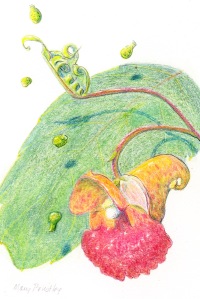Nineteenth century naturalist and illustrator William Hamilton Gibson wrote this about Impatiens capensis, most often called jewelweed or touch-me-not around here. The name jewelweed may come from the jewel-like beauty of its bright blossoms; touch-me-not for the explosive seed capsules.
Do you remember the first time someone showed you that if you squeeze a capsule gently, it will pop, sending the seeds flying? What a fun plant! It’s also useful. Some people swear by its power to ease the itch of poison ivy. The plant is mostly water – just rub it on your skin when you suspect that you’ve come in contact with poison ivy, or even after you’ve developed the rash. Jewelweed promises relief, they say.
It’s also a wonderful nectar plant for hummingbirds, and for insects with long proboscises, like butterflies and moths. Smart insects like bees, whose proboscises are too short to reach the nectar hidden in the tip of the flower’s spur, learn quickly to bite into the tip and steal the nectar.
Jewelweed is one of the few annuals that inhabit our rich, undisturbed woods. Swelling pairs of cotyledons, sighted just as the spring ephemerals come into bloom, signal jewelweed’s germination. The lifestyle of an annual is a good bit more “desperate” than that of a herbaceous perennial. In order for the lineage to survive, the plant must be pollinated, develop viable seeds, and disperse those seeds to a habitable spot, all within one growing season. Perennials, on the other hand, can afford to miss being pollinated some summers – they usually have another chance next year.
We have two species of jewelweed here on the Domain – this orange-flowered Impatiens capensis and the yellow-flowered I. pallida. Both are blooming their heads off right now. The first frost – or even temperatures below 40 degrees or so – will put an end to this generation. Hurry, hurry! It may be hot now, but winter’s a-comin’ on!


I rubbed some jewelweed leaves on a fresh bee sting the other day. I’m not sure if it was just a placebo effect, but it immediately soothed the bite and didn’t bother me afterwards!
So many people have good faith in Imatiens’ ability to do this! I have read that it’s the buckets of water and soothing sap that dissolve the toxin in poison ivy and ease the pain in rashes and stings. But who am I to say? I just love the flowers and their funny fruits! Thanks!
Mary,
I remember walking down the Mountain Goat rail bed many years ago and near the top of the mountain there was a big swath..uh huh..SWATH of cardinal flower and jewelweed in the ditches. I was there as the hummingbirds were filling their tanks prior to migration. It was an absolute aerial war zone as the birds fought over rights to the nectar. I don’t know if my attraction to jewelweed is as strong as a hummingbirds but I like them a lot and find it hard to pass them by without taking a photograph and springing a few elaters. The flowers look like little pudgy goldfishes.
What a wonderful picture this conjures up for me! I hope I can get down there soon to see for myself, if they’re still there!
They are blooming in NY right now along the sides of the roads. Very pretty
Delighting the nature lovers and catering to the hummers there, too, I’ll bet!